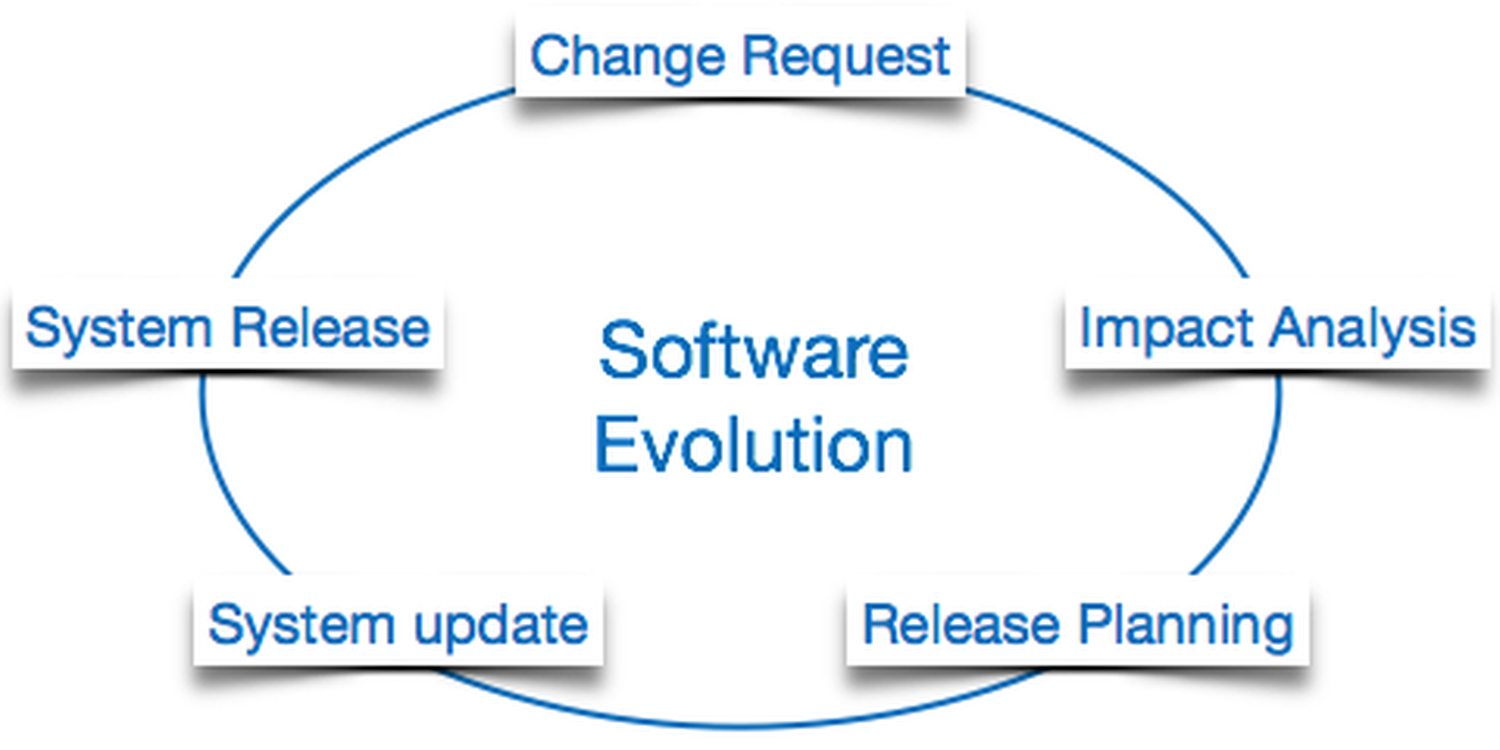Blog/Development
Understanding the Concept of Software Evolution.

Just as living organisms must adapt to various changes in their environments, software, too, must find a way to survive in this digital world. This phenomenon is described as the process of software evolution. Software evolution is the journey of how technology transforms and improves over time. It mirrors the underlying pursuit of perfection within the realms of algorithms and applications.
In this article, we’ll take you on an incredible journey of software evolution and how software, just like living organisms, evolves and thrives in this contemporary digital age.
Overview
- What is Software Evolution?
- Drivers of Software Evolution
- Stages of Software Evolution
- Why does Software Evolution matter?
- Challenges in managing software evolution
- Strategies for successful software evolution
What is Software Evolution?
Software evolution is the process through which a software program is developed, updated, and maintained over time to enable it to meet the evolving requirements of clients. Software evolution plays a very pivotal role in the Software Development Life Cycle (SDLC).
Evolution begins immediately after the development of a software product. The product is first launched (the initial release), after which it is delivered to its users. Feedback from users plays an important role in identifying their requirements, which are then subjected to thorough analysis. This analysis is carried out to determine the necessary changes, whether they arise from updates, the rectification of software bugs, or the integration of new technologies.
After the analysis is over, a plan is devised to outline the order in which the changes will be implemented. For major changes, the software modifications are designed to ensure that they align with the existing system. Developers then set to work, adhering to the approved plan, and once implementation is over, rigorous testing is carried out to ensure the system is functioning properly.
Crucially, any changes made must be meticulously documented, and the software program is continually monitored to confirm the successful implementation of the proposed changes. The updated software is then released back to its users until further alterations are deemed necessary- and the software evolution process repeats itself.
Drivers of Software Evolution
There are various factors that push software developers to continue to implement changes to drive the software evolution process. These factors include:
1. Bugs and defects:
Once software becomes older, the likelihood of bugs and errors emerging increases. As a result, it is necessary to continually implement changes and rectify errors to ensure that the software operates as it should.
2. Changes in the environment:
As environmental changes occur, there is a need to adapt to these changes. Thus, software needs to be constantly updated with new features to stay ahead in the competitive industry.
3. Security vulnerabilities:
It is no news that cyber thefts are constantly on the verge for data-related information. To avoid the schemes put up by these attackers, software should be regularly assessed for any security concerns. If breaches are likely to occur, they should be promptly addressed through updates to protect users' data and privacy.
4. User Feedback:
This is the most important driver for software evolution. Feedback from users helps to provide insights into areas where improvements are required, compelling developers to implement changes that align with user needs and preferences.
5. Change in Technology:
As technology changes, there is a need for software evolution to make the software compatible with the latest developments. This ensures optimal performance with new hardware and software technologies.
6. Regulatory Compliance:
Laws can be passed for various reasons, such as to protect users' data and privacy. These laws have to be followed, so software updates are made to ensure that it remains compliant with legal requirements.
7. Performance Optimization:
Software needs implementation as the database of users increases. Changes are necessary to ensure that software can take care of all its users without any compromise, enhancing efficiency and responsiveness.
8. Change in Business Objectives:
Shifting business objectives may require the incorporation of new features or modifications to support any required changes. Software must align with these objectives to remain relevant and effective.
Stages of Software Evolution
There are four stages involved in the software evolution process. They include; Initial development, Evolution, Servicing and Phase-out.
Stage One: Initial Development
In the initial development stage, a software program is created from scratch and designed to fulfill specific user needs. During this phase, the software's purpose, functionality, and features are defined, and the initial version of the software is launched for users to utilize.to users.
Stage Two: Evolution
The evolution stage follows the initial development and is characterized by ongoing changes and updates to the software. These changes are driven by various factors, such as user feedback, the identification of bugs or defects, and changes in technology.
Stage Three: Servicing
Software continues to evolve until it gets to the servicing stage, where only minimal changes are made to ensure the software's current functionality and stability. This stage concentrates basically on ensuring the software remains operational. Typically, no new features are added during this stage.
Stage Four: Phase-Out
At this stage, no further changes can be made. While the software may still be in use, it is gradually approaching obsolescence. Any significant issues or faults that arise may require that the software be replaced, as it becomes increasingly impractical to maintain the aging software. The phase-out stage marks the end of the software's active lifecycle.
Why does Software Evolution Matter?
Imagine owning a hotel. You take care of it because it is what brings about income for you. The longer the hotel stays, the more renovations are needed to keep it standing for as long as possible. Just as a hotel needs continuous upkeep and renovations to remain attractive and functional, software must undergo ongoing changes to meet user needs, enhance security, and stay competitive.
Software evolution is very essential in the software development world. It ensures the effectiveness and efficiency of the software system over time. Here are some of the reasons why software evolution matters;
- To keep users satisfied with up-to-date software products. Regular software updates and improvements keep users satisfied by providing new features and addressing their evolving needs.
- Ensure security and protect software products from attacks by regularly updating and implementing necessary changes.
- Identify and fix bugs and resolve issues before they escalate, ensuring the software's performance remains reliable.
- Ensure that software is regularly adapted to changing user needs, providing a competitive edge, as software that remains static may become obsolete or less attractive to users.
- Reduce any risks associated with software vulnerabilities, making software more efficient and effective.
Challenges in Managing Software Evolution
Managing software evolution can be quite challenging, despite the numerous benefits it offers. These challenges are due to several reasons, which are;
1. Cost:
Implementing necessary changes and updates can be costly. This includes not only the financial aspects but also the allocation of resources, time, and effort.
2. Legacy Code:
A legacy code is a code that was written in the past and is no longer supported. These codes are too complex to be understood by developers and pose a great challenge to developers. If the original code author is no longer available, it might be very difficult to implement the necessary changes, which can therefore slow the evolution process.
3. Communication Problems:
Effective communication between all members of the development team is essential for software evolution. Miscommunication among team members can lead to misunderstandings, delays, and errors during the software evolution process.
4. User Training:
New features or new changes may require that development companies train users so as to know how to operate the software effectively. This can be a big challenge in software evolution due to the cost of logistics associated with user training.
5. Integration Complexity:
During software evolution, the interface may change, thus disrupting integration with other systems that require the old interface, leading to compatibility issues and complications when trying to connect the software with other existing systems or services.
Strategies for Successful Software Evolution
For effective software evolution, there are strategies that should be kept in place to address the challenges throughout the software lifetime.
The initial step is to define the reason behind the software's evolution clearly. This is crucial to ensuring that every change aligns harmoniously with the business goals and effectively meets the evolving needs of the users.
After gaining a clear understanding of the reason for evolution, implementation should begin in a step-by-step process, with the necessary modifications being executed in a structured sequence to prevent any further issues.
Gather feedback from your users to ensure that all changes and faults have been fixed and the software is running smoothly. If feedback is positive, ensure that all changes carried out are backed up, and a recovery procedure is put in place in case any further change is required.
Version control systems like Git should be used to track changes, ensure collaboration, and maintain a historical record of modifications in case previous versions want to be integrated with new updates. Agile methodology methods should also be implemented to ensure that software aligns with the changing needs of the environment.
After that, tests should be carried out to verify the safety and integrity of the implemented changes. Once these tests are over, a comprehensive review of the software should be conducted to ascertain its quality.
Conclusion
Software evolution is a process that continues throughout the lifecycle of software. It requires collaboration and commitment between team members to ensure that the project delivers value to its users. Additionally, it ensures that the software remains secure and capable of meeting the changing needs of the environment. Remember, Software evolution is a necessity, ensuring that software remains valuable at all times.
Related post
Recent Posts
Need help with a project?
© Wazobia Technologies 2025
Powered by:



.jpg_xZXBLo?tr=w-1500,cr-0.0.1500.840)
